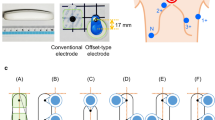Abstract
Changes in body position alter the relative angle between ECG electrodes and the mean electric axis of the heart. These changes influence the time interval during which the projection of the electric dipole, on any ECG lead, is positive (R-wave). In this study, measurements of R-wave duration (RWD) were used to identify changes in body position, and two of its uncorrelated features were used to classify each heartbeat into four basic groups relating to four body positions (supine, prone, left-side, right-side). Data were acquired from healthy volunteers during controlled condition experiments that included well-defined sequences of body positions and simultaneous recordings of ECG leads I, II and III. Results showed over 90% correct identifications ofbody position changes when using any of the three leads. Lead II had the best performance for theclassification of body position and correctly classified 80% of heartbeats. Classification did not improve for a combination of two leads. The technique can be used to reveal additional important clinical information and can be easily implemented, in a variety of applications where ECG is recorded, such as sleep studies, Holter recordings and ischaemia detection.
Similar content being viewed by others
References
Adams, M. G., andDrew, B. J. (1997): ‘Body position effects on the ECG—implication for ischemia monitoring’,J. Electrocard.,30, pp. 285–291
Akselrod, S., Gordon, D., Ubel, F. A., Shannon, D. C., Berger, A. C., andCohen, R. J. (1981): ‘Power spectrum analysis of heart rate fluctuation: a quantitative probe of beat-to-beat cardiovascular control’,Science,213, pp. 220–222
Baharav, A., Kotagal, S., Gibbons, V., Rubin, B. K., Pratt, G., Karin, J., andAkselrod, S. (1995): ‘Fluctuations in autonomic nervous activity during sleep displayed by power spectrum analysis of heart rate variability’,Neurology,45, pp. 1183–1187
Bijan, S., Lu, A. F., andStoller, M. L. (2001): ‘Correlation of unilateral urolithiasis with sleep posture’,J. Urol.,165, pp. 1085–1087
Bland, J. M., andAltman, D. G. (1986): ‘Statistical methods for assessing agreement between two methods of clinical measurement’,The Lancet,17, pp. 307–310
Bonnet, M. H., andArand, D. L. (1997): ‘Heart rate variability: sleep stage, time of night, and arousal influence’,EEG Clin. Neurophys.,102, pp. 390–396
Chambers, M. J. (1994): ‘Actigraphy and insomnia: a closer look’,Sleep,17, pp. 405–408
De Koninck J., Gagnon P., andLallier, S. (1983): ‘Sleep positions in the young adult and their relationship with the subjective quality of sleep’,Sleep,6, p. 52
Duda, R. O., Hart, P. E., andStork, D. G. (2001): ‘Pattern classification’ (John Wiley & Sons, Inc., New York, USA, 2001), Chap. 10
Goldberger, A. L., andGoldberger, E. (1994): ‘Clinical electrocardiography’ (Mosbey Year Book, St. Louis, USA, 1994), Chap. 5
Hakim, T. S., Dean, G. W., andLisbona, R. (1988): ‘Effect of body posture on spatial distribution of pulmonary blood flow’,J. Appl. Physiol.,64, pp. 1160–1170
Jager, F., Moody, G. B., andMark, R. G. (1998): ‘Detection of transient ST segment episodes during ambulatory ECG monitoring’,Comput. Biomed. Res.,31, pp. 305–322
Moody, G. B., Mark, R. G., Zoccola, A., andMantero, S. (1985): ‘Derivation of respiratory signals from multi-lead ECGs’,Comput. Cardiol.,12, pp. 113–116
Morielli, A., Ladan, S., Ducharme, F. M., andBrouillette, R. T. (1996): ‘Can sleep and wakefulness be distinguished in children by cardiorespiratory and videotape recording?’,Chest,109, pp. 680–687
Narkiewicz, K., andSomers, V. K. (2001): ‘Cardiovascular variability characteristics in obstructive sleep apnea’,Auton. Neurosci.,90, pp. 89–94
Ng, J., Sahakian, A. V., andSwiryn, S. (2000): ‘Sensing and documentation of body position during ambulatory ECG monitoring’,Comput. Cardiol.,27, pp. 77–80
Ohlsson, M., Ohlin, H., Wallerstedt, S. M., andEdenbrandt, L. (2001): ‘Usefulness of serial electrocardiograms for diagnosis of acute myocardial infarction’,Am. J. Cardiol.,88, pp. 478–481
Pagani, M., andLucini, D. (2001): ‘Autonomic dysregulation in essential hypertension: insight from heart rate and arterial pressure variability’,Auton. Neurosci.,90, pp. 76–82
Raymond, B., Cayton, R. M., Bates, R. A., andChappell, M. J. (2000): ‘Screening for obstructive sleep apnoea based on the electrocardiogram—the computers in cardiology challenge’,Comput. Cardiol.,27, pp. 267–270
Shinar, Z., Baharav, A., andAkselrod, S. (1999): ‘R wave duration as a measure of body position changes during sleep’,Comput. Cardiol.,26, pp. 49–52
Shinar, Z., Baharav, A., andAkselrod, S. (2000): ‘Obstructive sleep apnea detection based on electrocardiogram analysis’,Comput. Cardiol.,27, pp. 757–760
White, D. P. (1996): ‘Complex home monitoring’,Sleep,19, pp. S248-S250
Author information
Authors and Affiliations
Corresponding author
Rights and permissions
About this article
Cite this article
Shinar, Z., Baharav, A. & Akselrod, S. Detection of different recumbent body positions from the electrocardiogram. Med. Biol. Eng. Comput. 41, 206–210 (2003). https://doi.org/10.1007/BF02344890
Received:
Accepted:
Issue Date:
DOI: https://doi.org/10.1007/BF02344890




